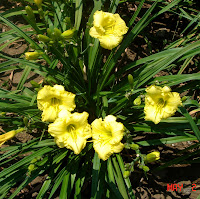
Crabapple LandscapExperts say, "If ever there was a sure thing in the gardening world, it has to be daylilies!" They are easy to grow, drought-tolerant perennials and are a familiar sight in metro-Atlanta Gardens. They tolerate a wide range of soils, are not troubled by diseases or pests, and bloom faithfully every summer, typically around Father's Day in Atlanta. They also thrive in containers, great for small gardens with limited space.
Large clumps with long, skinny leaves produce at least a dozen flower scapes in June. Their botanical name, Hemerocallis, means “beauty for a day”. It’s true, each flower lasts only one day. But since there are many buds on each flowering stalk, the blooming season for individual plants lasts several weeks, as they open one-by-one in turn. The American Hemerocallis Society (www.daylilies.org/daylilies.html) lists thousands of named daylily varieties and gives the number of days in bloom for each one.
The most famous long-time bloomer is “Stella d’Oro”, with small, 2-3 inch, “school bus yellow” flowers that bloom continuously for about ten months of the year. These are widely available in Intown nurseries and garden centers. However, there are many improvements on this hardy little landscape variety, and newer versions are much more versatile colors that blend in well with other garden plants. For example, look for the Enjoy 24/7 Daylily Collection from Garden Debut or the reblooming 'Going Bananas' from Proven Winners.
There are many kinds of daylilies. The most common way to group them is by time of bloom: early, mid-season, or late. Other ways to categorize daylilies include flower size (up to 7 or 8 inches); luscious colors ranging from white through yellow, peach, orange and red to pink and violet, or height of the scapes. Flower forms encompass trumpet, recurved, double and ruffled. Petal edges can be smooth, or have ruffled and shirred “piecrust” edges. Some flowers are brushed with an iridescence down the main rib of each petal called “Diamond dust”. By mixing and matching daylilies of various heights, flowers and shapes, I can prolong the display in my garden.
Another category are daylilies with the “open evenings” label. Although old-fashioned daylilies close at the end of the day, the newer ones are bred to stay open during the long summer evenings, adding to the enjoyment of the summer garden.
Normal daylilies with loads of smaller flowers have 22 chromosomes and are called “Diploids”. “Tetraploids” have double the number, with 44 chromosomes and are noticeably more vigorous, with larger, more intensely colored flowers on stronger scapes. “Miniature” varieties grow a mere 12-24 inches tall, with smaller flowers.
A few daylilies are fragrant, notably the old-fashioned, tall, Lemon Lilies. Some daylilies are evergreen, retaining a small green tuft all winter, while others are semi-evergreen or dormant, disappearing during winter to re-emerge each spring.
Daylilies flower best when planted in sun (6 hours or more per day) with a bit of shade in the afternoon. They prefer moist, yet well-drained soil. Amend the soil with compost when first planting and space plants 12 to 18 inches apart. Plant at the same level they were growing in the pots, or with bare root daylilies, plant the crown about an inch beneath the soil. Water in thoroughly, mulch, and later scratch some compost in around the root zone once a year.
Even if you cannot meet these conditions, go ahead and plant daylilies just about any place, including large containers, and they will do their best to provide you with a marvelous show. Your Crabapple Rep will be happy to discuss adding some daylilies to the landscapes on the property you manage.





No comments:
Post a Comment